It is difficult to measure success when it comes to something as diverse and culturally important as Yamaha’s line of motorcycles. Since the end of World War II, Yamaha has firmly established itself as one of the leading producers of motorcycles in the world. From straight-away racers to adventure bikes, Yamaha has mastered it all. So, how do we determine which bikes are the most successful?
We measure success in many different ways. Of course, there is monetary success and longevity. Bikes that stayed in production for a decade or generated the most revenue fit the classic definition of success. But we’re looking past all that, considering the cultural impact of each bike on this list.
Some of Yamaha’s motorcycles changed how the public thinks about what makes a standout motorcycle. Many of the bikes on this list caused such a stir upon release that they solidified their place in history without the highest sales figures or the fastest quarter mile.
Here, we will discuss more than just when and where Yamaha bikes are made and how their sales figures compare. We will explore the societal impact these bikes had on the world of motorcycles, and celebrate Yamaha’s impact on the collective consciousness of riders everywhere.
Yamaha 1955 YA-1
Looking at the most successful Yamaha Motorcycles through the years, the 1955 Yamaha YA-1 is the best place to start. This bike was Yamaha’s first motorcycle, introduced as Japan was trying to recover economically from WWII.
In the post-war years, the need for ammunition shifted to the need for better transportation. Domestic Japanese and international motor companies scrambled to make commercially viable powered bikes and motorcycles. Yamaha was no different. It developed the YA-1 and made a name for itself in the competitive motorcycling world.
The original YA-1 prototype was tested in 1954. Engineers designed this motorcycle with a two-stroke single engine that could start in any gear using its kick-starting system. You just had to make sure the clutch was released. You could also shift directly to neutral with just a half-stroke of the lever from any gear. These innovative features made the bike stand out from competing companies like Honda and Harley Davidson.
Yamaha YA-1 was put to the test in many Japanese domestic races. After taking first prize in several racing events, the company was inspired to go bigger. As Yamaha expanded its range of motorcycles domestically and globally, the company maintained the innovative spirit of the Yamaha YA-1.
Yamaha RD350 LC YPVS
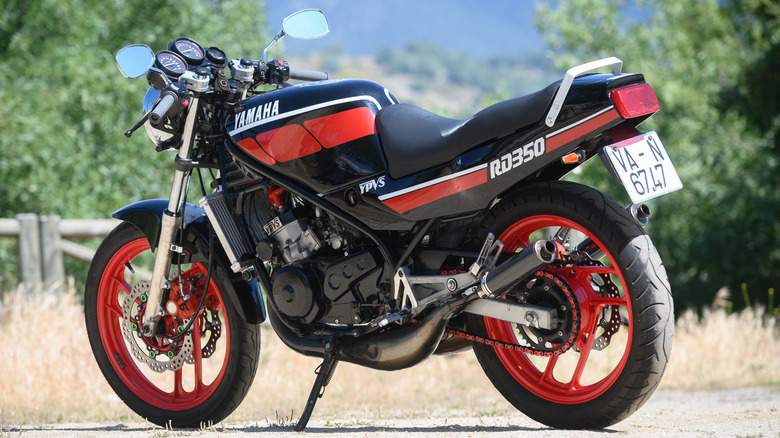
FernandoV/Shutterstock
Released in the early 80s, the RE350LC made a huge impression on the racing scene and became particularly popular in the U.K. market. This model combined agility and power in its lightweight design and inventive cooling system. It gained a following and lives in the memories of engineers and riders.
In the late 1970s, Yamaha knew its RD series motorcycles needed an update. The two-stroke engine was under fire as emission regulations in the U.S. began to tighten, so it decided to make the new RD350 YPVS for the European market. The intention was to make a racing motorcycle similar to the TZ models built for the streets.
Yamaha chose to maximize power and performance with the RD350LC YPVS. This model implements the Yamaha Powervalve System, allowing the bike to extract more power from the engine at higher revs. This system makes the bike easier to handle in everyday riding situations.
The RD350LC YPVS also implemented a liquid-cooled engine borrowed from the TZ. This provides a successful sequel to the previous RD250 and 400 models. This racing bike for the street had some of the best technology available at the time. It quickly became one of the most iconic bikes produced by Yamaha.
Yamaha XS-1100
The Yamaha XS-1100, popularly known as Eleven, is another standard motorcycle produced in 1978. This bike was designed to be fast in a straight line, have a soft suspension, and be enjoyable for anyone willing to push the throttle.
This motorcycle makes our list because it was one of the first Yamaha bikes to push past 1000ccs. The XS-1100’s DOHC in-line four-cylinder 1,100cc engine was not designed for the Japanese market. It was, however, widely accepted by American and European connoisseurs. On top of the large engine size, it also was the first four-stroke build by Yamaha. The company decided to make a statement with the XS-1100.
This bike was built to move. It had 95 hp and 66 lb-ft of torque. It was popular with riders and reporters. The Eleven won Best Touring Motorcycles in 1978 and 1979 from Cycle World magazine. The magazine called the bike «a Rolls Royce with a blown Chrysler Hemi motor.» This statement speaks to the bike’s success and power. Though it was built when handling wasn’t the most important feature on a motorcycle, the 11-second half-mile solidifies the XS-1100’s place in history.
[Featured image by Farmforce via Wikimedia Commons | Cropped and scaled | CC BY-SA 4.0]
Yamaha YZF-R1
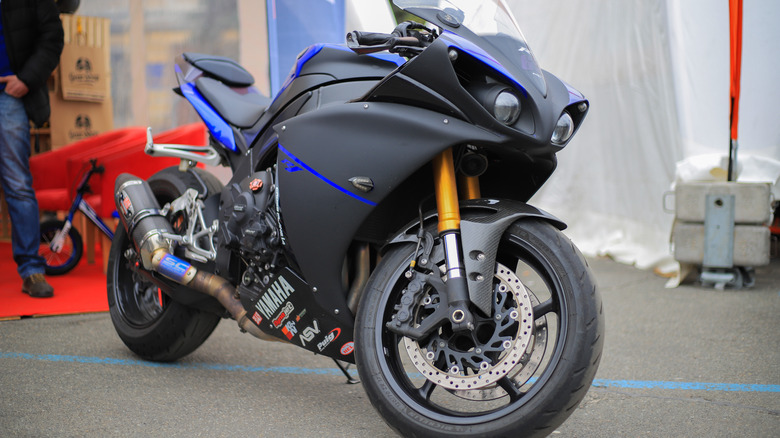
Viktor4ik/Getty Images
In 1998, Yamaha struck gold with the YZF-R1. Before the release of the YZF-R1, superbikes were defined as having 750cc four-cylinder and 1000cc twin engines. These older bikes were built for the road. The YZF-R1 focused on one thing and one thing only: speed.
The Yamaha YZF-R1 took sports bikes to the next level. The original bike was all power with very little else. If a feature did not help this motorcycle go fast, it was scrapped. This bike boasts a 998cc inline-four engine, 150 hp, and 72.5 lb-ft of torque. It also had a stacked gearbox, something that is standard on all superbikes today but was trailblazing in the late 90s.
The early 90s saw a slump in superbike sales. Yamaha realized it needed to step up its game to stay competitive. Yamaha designer Kunihiko Miwa was given free rein over the motorcycle’s design. He pioneered the «three-axis» design, which set the primary shaft and crank right next to each other. This experimental construction proved that Yamaha could create a machine that would leave its competitors in the dust.
The YZF-R1 changed superbikes forever. Its 25 years of consistent manufacture are a credit to its success. Many still regard this bike as one of the best, if not the best, superbikes ever manufactured.
Yamaha Super Tenere
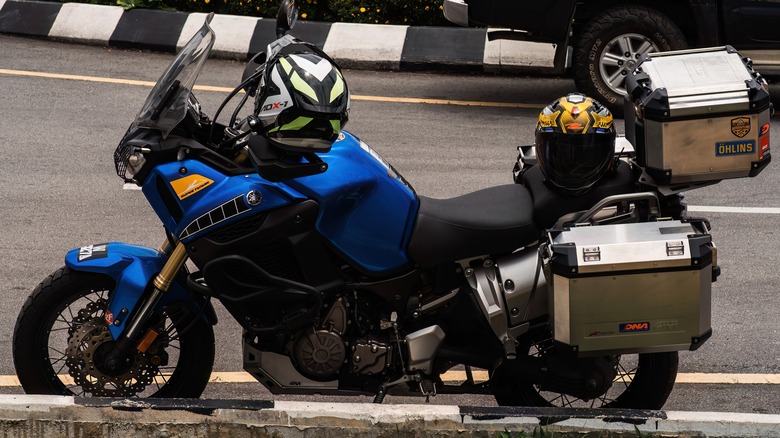
ellinnur bakarudin/Shutterstock
This list wouldn’t be complete without a nod to the adventure bike class. The 1989 Super Tenere was a bike designed for suspension and stability. Taking its name from the infamous Tenere stage of the Paris-Dakar race, this motorcycle became the companion of many serious long-distance riders.
The sturdy, comfortable frame of the Tenere was propelled by a 799cc parallel-twin engine. Its three-mode traction control system distributed power to where the rider needed it most. Whether you were making your way down a rocky mountain pass or through a treacherous river crossing, the Tenere was known to have the power and stability to get through any obstacle.
The bike is considered one of the most reliable Yamaha motorcycles ever built. The engine is situated in the far front of the cassis to help with traction. Standup pegs, tubeless wheels, and a 6.07-gallon fuel tank have kept adventurers in comfort in the most rugged situations.
While the Tenere was made for endurance, not speed, that design focus made it successful. It was a direct competitor to Honda’s African Twin, and these bikes rivaled each other in almost every way. They led the fight for dominance in the emerging adventure bike market, which is still ongoing.
Yamaha XT250
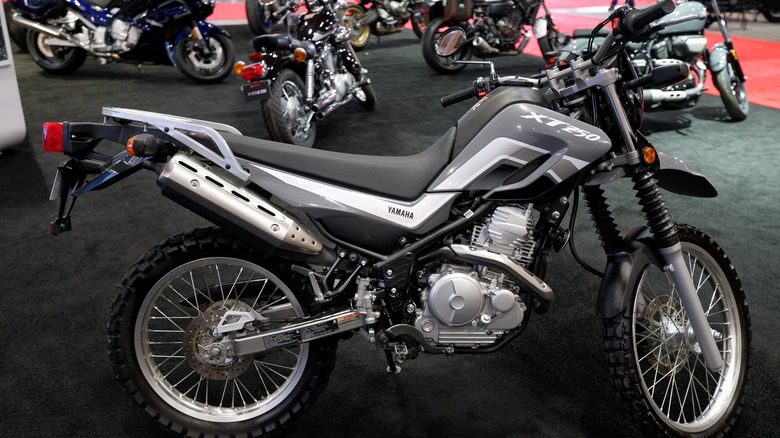
Zoran Karapancev/Shutterstock
Since its release in 1980, the Yamaha XT250 has become incredibly successful in the dual-sport market. It makes our list because of its undeniable popularity among beginners and pros. In 2008, the motorcycle got a facelift. With a low seat height and powerful fuel-injection engine, it is one of the best Yamaha motorcycles for beginners.
The XT250 is powered by a 249cc air-cooled four-stroke SOHC (single overhead camshaft) two-valve single-cylinder engine, which is known for its reliability. Riders of the XT250 will spend more time on the road than in the garage. Its low-maintenance nature has made this bike popular with anyone who wants to spend more time on or off the road.
This motorcycle switches seamlessly from street to trail. The front and rear disk breaks and the top-of-the-line suspension make this bike easy to handle in difficult situations. The XT250 is a perfect combination of power and versatility, making it an ideal choice for riders seeking adventure both on and off the road.
Yamaha V-Max
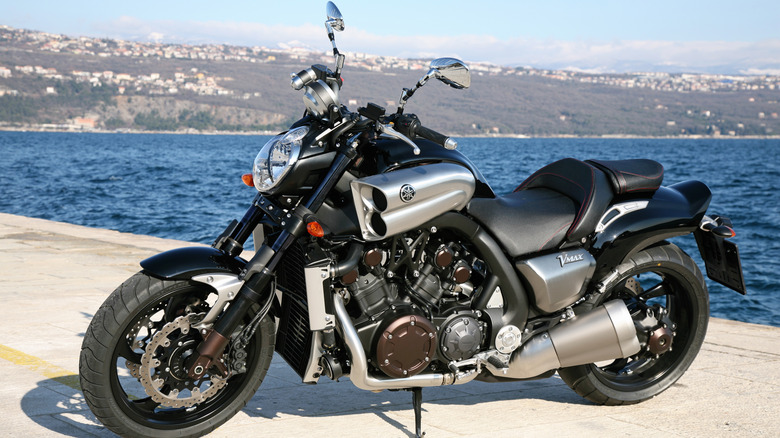
Vuk8691/Getty Images
The Yamaha V-Max began production in 1985. This beast of a machine radiated power, with an aggressive design that set it apart from other cruisers at the time. Its visual appeal made this bike popular for enthusiasts looking to make an impression. That distinct style, along with the bike’s unmatched longevity, secures the V-Max a spot on our list.
The thing that really sets the V-Max apart is its V-Boost technology. The engineers at Yamaha invented a means to interlink carburetor intakes, allowing two carbs to feed each cylinder instead of the traditional one. The effect of the V-Boost was maxing out at 143 brake horsepower (bhp) at 8,000 RPM. The V-boost would activate around 6,000 RPM. The result was the muscle power behind this muscle bike.
The V-Max also received significant critical acclaim. Its continued evolution through its 35-year run kept riders and critics in awe of its power and style. Though there were some concerns regarding the V-Max’s cornering ability and soft suspension, it ultimately generated enough power to blow nay-sayers away. Its unique and strong image continued to interest consumers. It is still considered one of the most iconic bikes produced by Yamaha.
Yamaha SR series
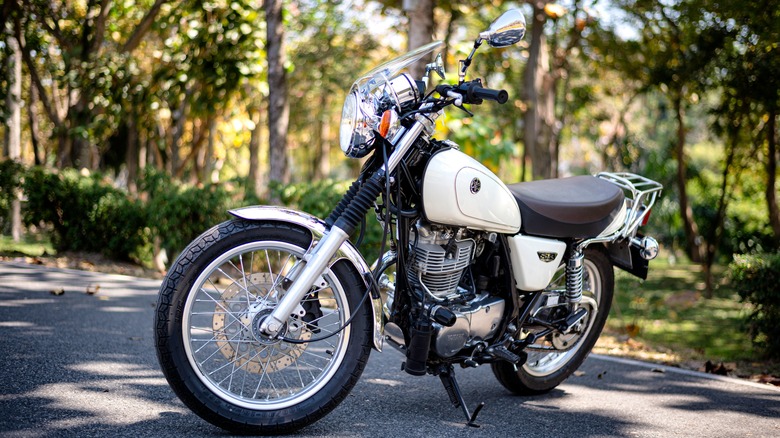
501room/Shutterstock
The Yamaha SR series started in 1978 and quickly gained popularity as a versatile and reliable bike. They are easy to use and perfectly suited to new riders. The SR series’ success is largely due to its customizability. These bikes are also aimed at those who want the aesthetic of a classic motorcycle while being able to hop on and ride off with confidence in the bike’s reliability.
The bikes in the Yamaha SR series are powered by engines of different sizes, depending on the specific model. Most have an air-cooled four-stroke single-cylinder engine. The newer bikes in the series have a fuel-injection engine. This engine reduces emissions while operating smoothly in many different conditions.
Adding to the classic style of the SR series the 2014 model can only be engaged by kickstart. This throwback feature adds to the classified style while making riders feel they are truly in touch with their machine. All of the carefully crafted features of the SR series have kept them incredibly popular in their 35-plus year run.
Yamaha YZ250
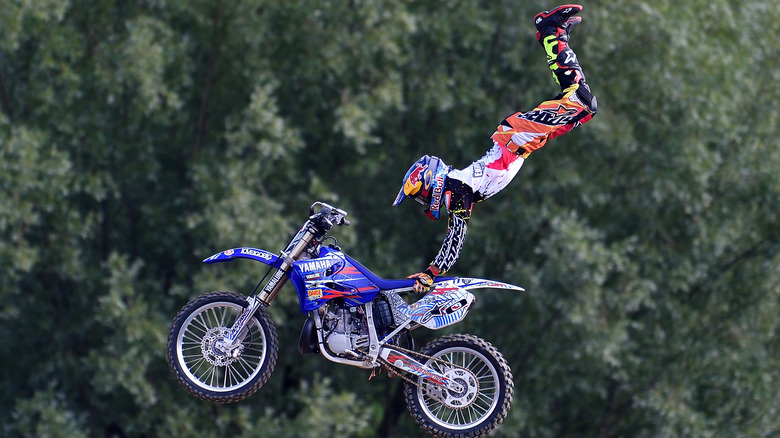
Thananuwat Srirasant/Getty Images
When talking about the best Yamaha motorcycles ever made, you must include at least one entry about Yamaha’s dominance in motocross. Considered by some the pinnacle of agility and strength, the lightweight YZ250 has a sturdy chassis designed to handle the harsh impact of motocross and give riders near-complete control. It has an excellent fully adjustable suspension that’s ideal for handling all the bumps and jumps of the track.
Another key feature of the YZ250 is its powerful water-cooled two-stroke engine. This was the first dirt bike to equip a water-cooled engine, and it was a game-changing addition in the world of motocross.
The YZ250 was designed for motocross riders — it is purpose built for off-road racing. Yamaha engineers anticipated the significant punishment this bike would endure and made a extra effort to ensure comfort. It doesn’t boast any rear electrical aids, thought it sports a digital ignition system, which keeps it reliable and easily maneuverable despite the lack of bells and whistles.
Overall, this bike has a lot to offer motocross enthusiasts. It is lightweight and powerful, with a high-performance engine and adjustable suspension that make it an iconic choice for anyone serious about getting some air time.
1975 Yamaha XT500
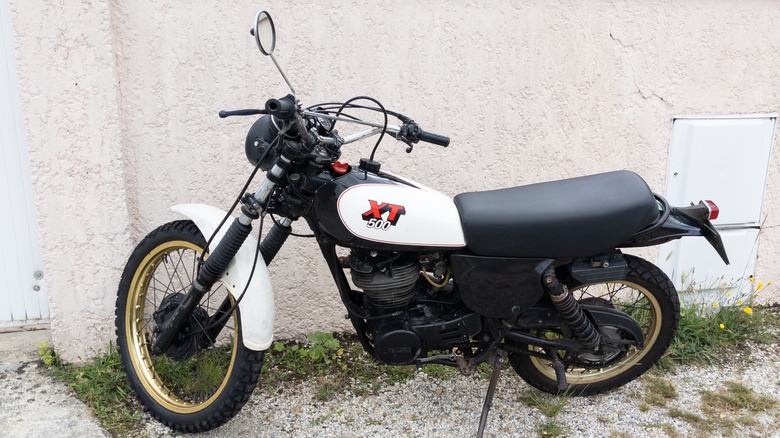
sylv1rob1/Shutterstock
The 1975 Yamaha XT500 was so successful in its original form that it remained almost unchanged for 14 years. This bike was unveiled in Las Vegas in 1975, hoping to attract American buyers. It was a massive success, winning the Paris-Dakar Rally in 1979 and 1980.
The 1975 XR500 is an enduro motorcycle designed for use on and off-road. Its appearance on the motorcycle scene transformed the duel-sport market. Its impressive 499cc engine gives it 32 hp and 29 lb-ft of torque. Its light frame and off-read suspension gave it the agility of a sports bike with the maneuverability of a dirt bike. It is no wonder this bike has maintained its popularity over the years.
After production ceased in 1989, you might expect the XT500’s success to wane, but you would be mistaken. The bike quickly became the object of collectors’ and enthusiasts’ desires. Its impeccable record and reputation for quality keep this motorcycle at the top of many lists.